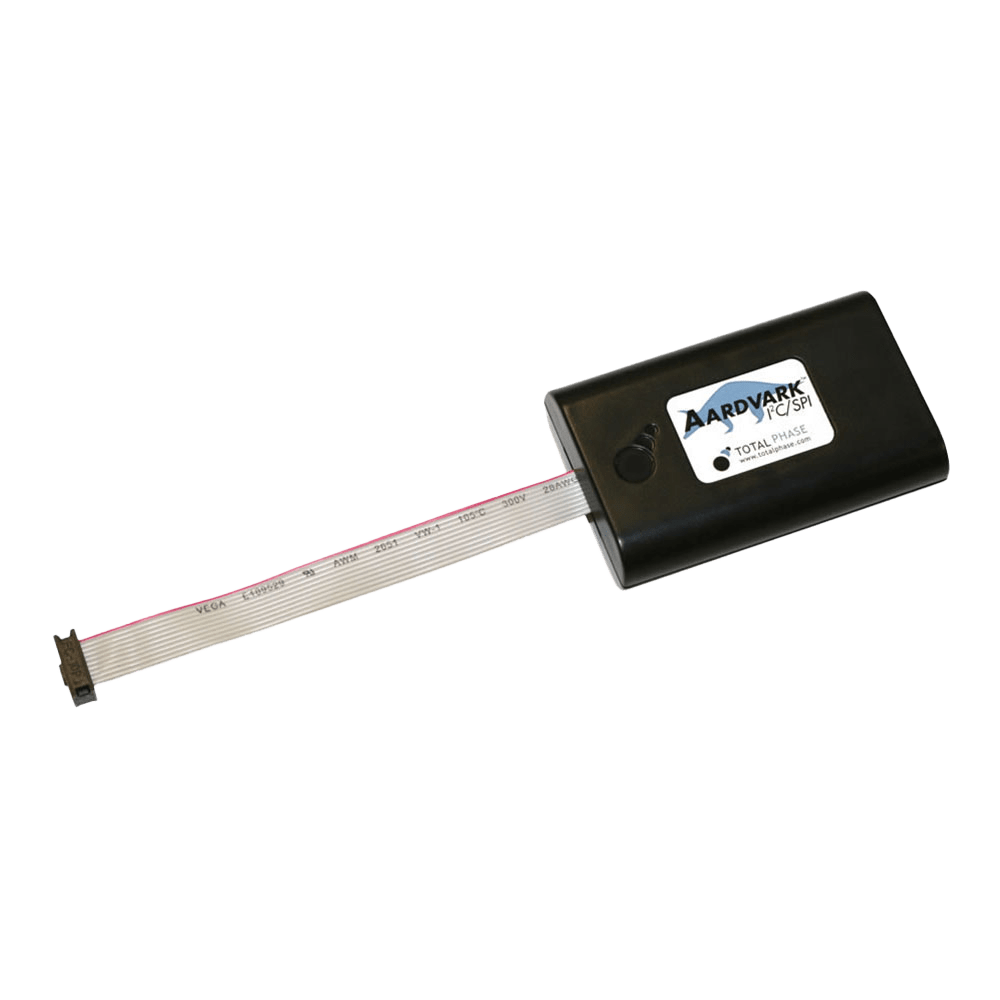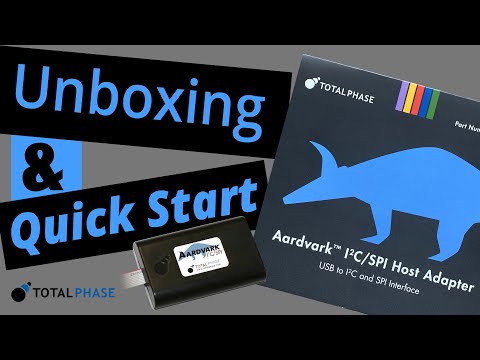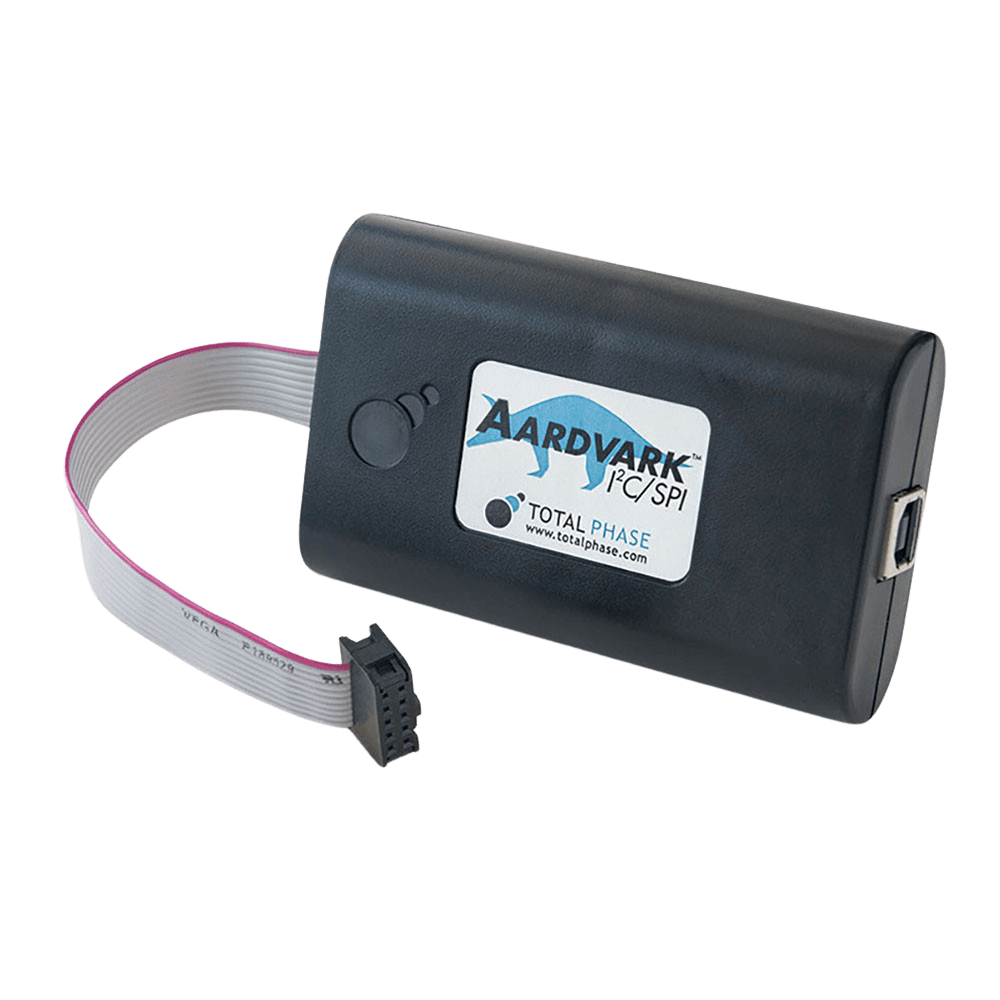
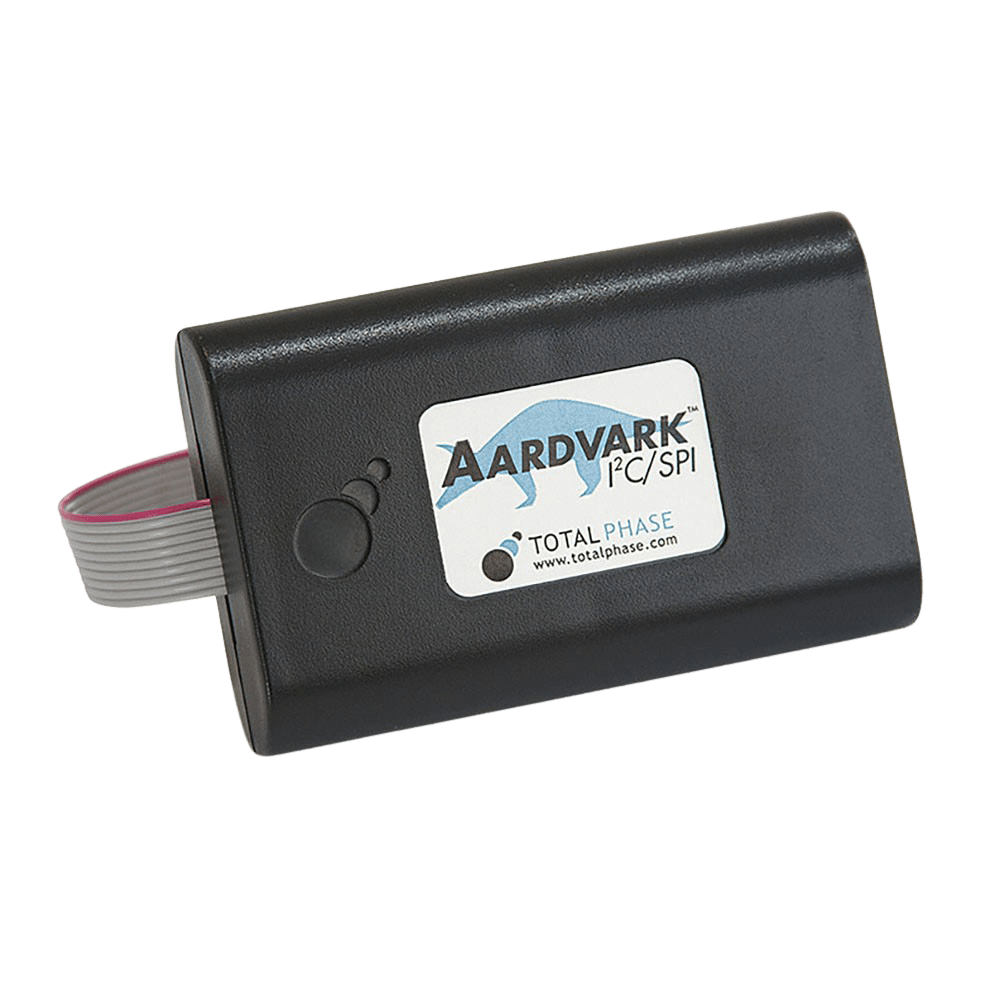
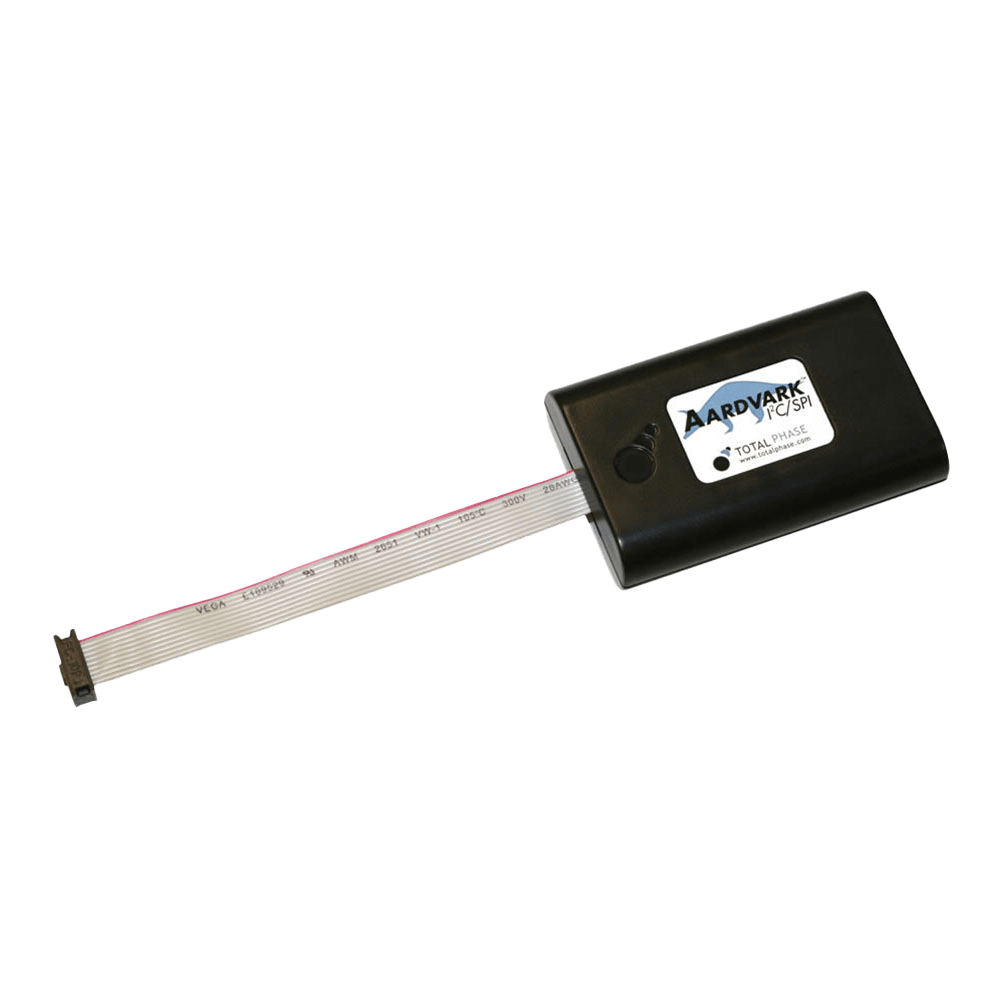
Key Features
Overview
Buy an Aardvark I2C/SPI and get 10% off a Beagle I2C/SPI*
The Total Phase Aardvark I2C/SPI Host Adapter is a USB-powered tool that enables direct, bidirectional communication with I2C and SPI devices from a Windows, Linux or macOS computer. It supports master and slave operation up to 800 kHz for I2C and up to 8 MHz/4 MHz for SPI master/slave, making it suitable for sensor evaluation, EEPROM/Flash programming, and automated test workflows. The standard 2×5 IDC target connector provides I2C, SPI and up to six GPIO lines; +5 V target power is available for low-current devices.
The included Control Center Serial software simplifies configuration and message transactions, with XML batch scripting for automation. Flash Center streamlines programming of I2C and SPI memories using an extensible parts library. Cross‑platform APIs (C/C/C#, Python, .NET) and LabVIEW drivers are available for integration into custom tooling.
Aardvark sits within a family of Total Phase tools: the higher‑performance Promira Serial Platform adds integrated level shifting and much higher I2C/SPI speeds, while the Beagle I2C/SPI Protocol Analyzer provides non‑intrusive bus capture—often used alongside Aardvark for concurrent generate‑and‑monitor workflows.
For engineers who need a dependable, well‑supported host adapter for everyday I2C/SPI bring‑up and production scripting, Aardvark delivers capability without complexity.
Downloads
Why Engineers Choose The Total Phase Aardvark I2C/SPI Host Adapter
Industry Standard Tool
Master/Slave Flexibility
Complete Software Ecosystem
Full Description
The Total Phase Aardvark I2C/SPI Host Adapter is a USB-powered host adapter designed for electronic design engineers who need reliable, controllable access to I2C and SPI buses during bring-up, debugging, and production scripting. Operating as both master and slave, it supports I2C at up to 800kHz and SPI at up to 8MHz in master mode (4MHz in slave mode), with a standard 2×5 IDC target connector exposing I2C (SCL/SDA), SPI (MOSI/MISO/SCLK/SS) and up to six GPIO signals. It interfaces over USB to Windows, Linux, and macOS, and is supplied with the Control Center Serial GUI, Flash Center programming utility, and cross-platform APIs for C/C/C#, Python and .NET. With target power output available at +5V for low-current devices and a compact footprint that fits easily on a crowded bench, it provides a dependable link between a computer and digital peripherals without imposing unnecessary complexity.
USB to I2C Master/Slave Control up to 800kHz for Fast Bring-up
As an I2C host adapter, the Aardvark operates in both master and slave modes across typical development speeds from a few kilohertz up to 800kHz. This covers Standard-mode (100kHz) and Fast-mode (400kHz) devices comfortably and provides headroom for designs that push closer to 800kHz during evaluation. Master mode enables scripted register access, burst reads, and device initialisation sequences, while slave mode allows engineers to emulate peripherals to test a host SoC’s behavioural edge cases. In practice, this means a board with a temperature sensor and an EEPROM can be validated quickly by writing configuration registers, verifying ACK/NACK behaviour, and reading back calibration data under repeatable conditions. The direct benefit is reduced time-to-first-success during board bring-up: with deterministic control of bit rate, addressing (7-bit/10-bit), and transaction framing, engineers can focus on root cause rather than fighting tool setup.
SPI Master to 8MHz and Slave to 4MHz for Peripheral Exercise
On SPI, Aardvark supports master mode up to 8MHz and slave mode up to 4MHz, with control over mode (CPOL/CPHA), bit order, and chip select handling across the 2×5 IDC header. These rates are well suited to common flash memories, DACs/ADCs, motor controllers and LED drivers that are rarely exercised above 10MHz during early validation. By driving deterministic patterns and parsing responses in the same session, an engineer can rapidly iterate on timing hypotheses—switching between Mode 0 and Mode 3, for example—to isolate sampling edge issues. When used as an SPI slave, Aardvark can emulate a sensor or memory device to verify that a microcontroller’s SPI driver adheres to command framing and timing requirements, a practical way to catch off-by-one and CS deassertion bugs before firmware freeze. The measurable outcome is fewer lab cycles and clearer pass/fail criteria for interface readiness.
Standard 2×5 IDC Target Connector with I2C, SPI and up to Six GPIOs
The adapter’s 2×5 IDC (2.54mm pitch) target connector presents a predictable, lab-friendly pinout: I2C (SCL, SDA), SPI (MISO, MOSI, SCLK, SS), ground, +5V target power for low-current devices, and up to six GPIO lines. Engineers benefit from quick swaps between fixtures and DUTs using ribbon cables that are already commonplace on mixed-signal benches. GPIOs can toggle control pins such as resets, enables, or mode selects, or sample status lines to coordinate test steps. This consolidation reduces the need to juggle multiple USB widgets for simple digital manipulation. In a concrete scenario, a GPIO can hold a PMIC in shutdown while SPI writes a configuration to a companion device; then a GPIO release triggers power-up to verify a clean boot sequence under scripted control.
Control Center Serial GUI for Interactive Debugging and Repeatable Automation
The supplied Control Center Serial application makes the Aardvark immediately productive without writing code. Engineers can configure bit rates (I2C up to 800kHz; SPI up to 8MHz), bus modes, and active lines, then compose transactions interactively to poke registers or stream data. Crucially, the GUI supports batch execution via XML scripts, so a proven manual sequence can be captured once and re-run as an automated regression across firmware revisions or PCB spins. This is particularly useful for validating that a board still boots and enumerates properly after an ECO, or that an I2C expander’s configuration survives power cycles. For teams, scripts become lightweight test fixtures—repeatable, reviewable, and version-controlled—without the upfront cost of a full test framework.
Flash Center Utility for I2C/SPI EEPROM and Flash Programming
For memory programming tasks, the Flash Center utility streamlines operations on I2C and SPI EEPROMs and NOR flash devices using an extensible parts library. Engineers can select a device, set the required speed (e.g., I2C at 400kHz for 24-series EEPROMs or SPI at several megahertz for 25-series flash), and program images with automatic page handling and erase/write sequencing. This saves time compared to hand-coding page-aligned transactions and status polling, and reduces the chance of subtle mistakes such as failing to wait for WIP bits to clear. In production support, this enables quick field updates to peripheral images or calibration data. During development, it’s invaluable for restoring golden images after deliberate corruption tests or validating that bootloaders correctly read a known-good payload.
Cross-Platform APIs for C/C/C#, Python and .NET to Integrate with Test Benches
The Aardvark includes cross-platform APIs and bindings for C, C++, C#, Python and .NET on Windows, Linux and macOS. This allows the adapter to plug into existing test harnesses and CI pipelines. Engineers can write concise scripts to exercise I2C at 100kHz for power-on defaults, then switch to 800kHz to stress-read buffers, or sweep SPI from 1MHz to 8MHz to bracket timing margins. Return codes and exceptions can be mapped directly to pass/fail criteria and logged alongside firmware and PCB revision identifiers. Integrating these scripts with a logic analyser such as a Saleae mixed-signal instrument provides protocol decode corroboration, so a single test run both drives traffic and captures waveforms for later review, tightening feedback loops between hardware and firmware.
Master/Slave Emulation for Host and Peripheral Testing
Bidirectional capability is central to the Aardvark’s role in the lab. In master mode, it stands in for a microcontroller to validate sensors, PMICs, expanders, and displays before firmware is stable. In slave mode, it emulates the target peripheral to harden host drivers, particularly valuable when the real device is back-ordered or when controlled error injection is needed. For instance, by emulating an I2C temperature sensor that NACKs every fourth transaction at 400kHz, firmware robustness to transient errors can be characterised without specialised fixtures. Similarly, an SPI slave emulation at 4MHz can check that the host asserts chip select for the entire frame and respects required inter-byte delays, preventing field issues caused by marginal timing.
Everyday Debugging Scenarios: From Simple Checks to Edge Cases
In a simple scenario, an engineer validating a new sensor board uses I2C master mode at 100kHz to read WHO_AM_I, confirms the expected ID, then increases to 400kHz to stream measurements while adjusting GPIO-controlled ranges. If a register write appears ineffective, a quick cross-check with a logic analyser’s protocol decode confirms a missed stop condition; adjusting the transaction resolves it immediately. In another common case, programming a 25-series SPI flash at 8MHz to load a boot image takes minutes via Flash Center, after which the engineer uses slave mode at 4MHz to emulate a slightly slower device and ensure the host tolerates extended busy times. For edge cases, an engineer can script mid-transaction resets using a GPIO line while monitoring bus behaviour, reproducing elusive bugs such as stuck lines or CS race conditions and capturing them for the firmware team to fix.
Power and Physical Considerations for Bench Efficiency
The adapter is USB bus-powered, eliminating an external PSU and simplifying bench wiring. Target power at +5V is available for low-current devices, which is convenient when validating small breakout boards or low-power peripherals that do not yet have a stable on-board supply. The compact enclosure and standard ribbon cable reduce strain on fragile headers and make it straightforward to leave the adapter connected during extended testing. Engineers focused on 1.8V targets can pair the Aardvark with a suitable level shifter to align logic thresholds, maintaining signal integrity while exercising devices at representative speeds. This modular approach avoids over-investing in features that are only occasionally required, while keeping the core interface accessible and predictable.
Choosing the Right Tool in the Total Phase Ecosystem
The Aardvark sits alongside other Total Phase tools to cover a wide range of serial workflows. For designs that need much higher bus speeds or integrated, selectable voltage levels, consider stepping up to the Promira Serial Platform, which extends I2C into the multi-megahertz range and SPI beyond tens of megahertz with configurable level shifting and additional I/O resources. For non-intrusive capture and deep timing analysis, pair the Aardvark with a protocol analyser such as a Saleae mixed-signal logic analyser; this combination lets one tool generate traffic while the other provides timestamped protocol decode and waveform context. Where SPI throughput alone is critical at higher master rates, the Cheetah SPI Host Adapter is an alternative optimised for speed. Selecting among these options ensures the lab covers generation, capture, and performance corners without redundancy.
Related Products
For higher performance and integrated level shifting, explore the Total Phase Promira Serial Platform serial host adapter. For dedicated high-speed SPI generation, see the Total Phase Cheetah SPI Host Adapter for fast SPI master. To complement Aardvark with capture and protocol decode, consider a Saleae logic analyser mixed-signal instrument for protocol decode and timing correlation during debugging. If low-voltage targets are common, add a suitable level shifter; pairing Aardvark with a Total Phase Level Shifter Board for I2C/SPI voltage translation helps maintain signal integrity on 1.8V or 2.5V buses.
| General Information | |
|---|---|
Part Number (SKU) |
TP240141
|
Model |
|
Manufacturer Manufacturer of the product
|
|
| Functional Features | |
Applications |
|
| Electrical | |
Interface Types |
|
Interface Features |
|
Interface Speed |
|
Interface Connections |
|
| Software | |
Included Software |
|
Software Updates |
|
Host OS Compatibility Works with these Operating Systems
|
|
API/SDK |
|
Automation |
|
| Physical and Mechanical | |
Dimensions |
|
Weight |
1.0 kg
|
Operating Temperature |
|
| Other | |
Certifications |
|
Warranty |
|
Country of Origin |
|
HS Code |
|
EAN |
5055383601769
|
Frequently Asked Questions
Have a Question?
-
Can my Aardvark be Upgraded?
Yes, The Aardvark firmware is stored in internal Flash Memory, which can be updated, free of charge when new firmware is released by Total Phase. Total Phase offers this free service which secures your investment in their products.
-
Can I Program I2C/SPI Memory Devices?
Yes, the Aardvark can program a wide range of EEPROM and Flash memory using the Flash Centre™ software.
-
How Long is the Aardvark Warranty
The manufacturer's standard warranty is twelve months. However, The Debug Store offers a full two-year warranty. We can do this because the Aardvark is so reliable.
-
How is the Aardvark Powered?
The Aardvark is powered from the host PC via the USB cable. The power consumption of the Aardvark is typically just 25mA.
This avoids having to use a separate power supply. -
The Aardvark Supports I2C and SPI Buses. Can it be used with any other Interfaces?
Yes, The Aardvark Host Adapters will also support:
Display Data Channel (DDC)
System Management Bus (SMBus)
Power Management Bus (PMBus)
Smart Battery Bus (SBBus)
Intelligent Platform Management Interface (IPMI)
Two-Wire Interface (TWI) -
Can the Aardvark Support Multiple Slave Addresses?
Yes and no. The Aardvark can only behave as one I2C address node at any one time. However, the slave address can be changed by using the Aardvark API Software as required.
-
Does The Aardvark Support I2C Clock Stretching?
Yes, clock stretching is supported by the Aardvark as a Master or a Slave.
Clock stretching can only be initiated by the slave device. It does this to extend an I2C bus cycle. Note that not all I2C Master or slave devices may support clock stretching so this needs to be considered when clock stretching is relied upon. -
Can the Aardvark adapter be used for programming EEPROMs and Flash memory?
Yes, the Aardvark is excellently suited for programming I2C and SPI-based EEPROMs and Flash memory devices. The included Flash Centre Software supports over 500 memory chips from major manufacturers including Atmel, Microchip, Intel, STMicroelectronics, Cypress, and many others. The software provides an XML-based device library that can be extended for custom memory devices. Programming operations include reading, writing, erasing, and verifying memory contents with built-in error checking. The Aardvark can handle various memory types including 24FC series EEPROMs, AT25 series SPI Flash, and supports both page write and random access programming modes. For production environments, multiple Aardvark adapters can be used simultaneously for parallel programming operations.
-
Which programming languages and operating systems does the Aardvark support?
The Aardvark adapter supports multiple programming languages including C, C++, C#, Python 2/3, .NET, Visual Basic .NET, Visual Basic 6, and LabVIEW through its comprehensive API. It is compatible with Windows (7, 8, 10, 11), macOS (10.4 Tiger through 12 Monterey), and various Linux distributions including Ubuntu, Fedora, Red Hat, SuSE, CentOS, Debian, and Arch Linux in both 32-bit and 64-bit versions. The device comes with free software including Control Centre Software for graphical interface operations, Flash Centre Software for EEPROM/Flash programming, and a complete API with example code for custom application development. All software is provided licence-free and receives regular updates without maintenance fees.
-
Can the Aardvark adapter be used for programming EEPROMs and Flash memory?
Yes, the Aardvark is excellently suited for programming I2C and SPI-based EEPROMs and Flash memory devices. The included Flash Centre Software supports over 500 memory chips from major manufacturers including Atmel, Microchip, Intel, STMicroelectronics, Cypress, and many others. The software provides an XML-based device library that can be extended for custom memory devices. Programming operations include reading, writing, erasing, and verifying memory contents with built-in error checking. The Aardvark can handle various memory types including 24FC series EEPROMs, AT25 series SPI Flash, and supports both page write and random access programming modes. For production environments, multiple Aardvark adapters can be used simultaneously for parallel programming operations.
-
What GPIO capabilities does the Aardvark provide?
The Aardvark adapter provides up to 6 GPIO pins that can be configured for general-purpose input/output operations. When operating in I2C-only mode, the four SPI pins (MISO, SCLK, MOSI, SS) become available as GPIO pins numbered 02, 03, 04, and 05. Similarly, in SPI-only mode, the two I2C pins (SCL, SDA) can function as GPIO pins 00 and 01. Each GPIO pin can be individually configured as input or output, with internal pull-up resistors available for input pins. The GPIO functionality supports interrupt-like operations through the aa_gpio_change function, which can detect pin state changes within a specified timeout period. All GPIO pins operate at 3.3V logic levels with a maximum drive current of 10 mA per pin.
-
What is the maximum cable length and distance limitations for the Aardvark?
The standard Aardvark ribbon cable is 130.175 mm (5.125 inches) long with a 1.27 mm (0.050 inch) pitch. For extended distances, the cable limitations depend on the communication protocol and signal integrity requirements. High-speed SPI communications up to 8 MHz should use shorter cables to maintain signal integrity, whilst lower-speed I2C communications at 100-400 kHz can tolerate longer cable runs. The device can work with custom cables, but users must ensure proper impedance matching and signal integrity. For applications requiring longer distances, level shifter boards can be used to improve signal quality, and multiple Aardvark adapters can be daisy-chained for extended reach applications. The USB connection between the Aardvark and host computer follows standard USB cable length limitations of up to 5 metres for USB 1.1/2.0 connections.
-
What protocols and communication standards does the Aardvark support beyond basic I2C and SPI?
Beyond standard I2C and SPI protocols, the Aardvark adapter supports several related communication standards and variants. For I2C communications, it supports Display Data Channel (DDC), System Management Bus (SMBus), Power Management Bus (PMBus), Smart Battery Bus (SBBus), Intelligent Platform Management Interface (IPMI), and Two-Wire Interface (TWI). The adapter handles advanced I2C features including repeated start conditions, 10-bit addressing, combined format transactions, clock stretching, and multi-master configurations. For SPI communications, it supports configurable clock polarity and phase settings, adjustable slave select polarity, and both MSB-first and LSB-first bit ordering. The adapter can operate with various SPI variants and custom protocols through its flexible GPIO capabilities. Additional protocols can be implemented through custom software applications using the comprehensive API, enabling support for proprietary or specialised communication standards. The device's GPIO functionality allows implementation of bit-banged protocols or custom signalling schemes as required by specific applications.
-
Can multiple Aardvark adapters be used simultaneously on one system?
Yes, multiple Aardvark adapters can be connected and operated simultaneously on a single host computer. Each Aardvark device receives a unique port number that can be identified using the aadetect utility or aa_find_devices API function. This capability enables parallel programming of multiple memory devices, simultaneous monitoring of different bus segments, or independent control of separate embedded systems. The USB bus provides sufficient bandwidth and power for multiple Aardvark adapters, with each device consuming less than 100 mA. Software applications can open handles to multiple adapters concurrently and control them independently through separate API calls. This multi-adapter capability is particularly valuable in production environments where gang programming or parallel testing operations are required. The Control Centre Software can manage multiple connected Aardvark adapters through its device selection interface.
-
What is the Total Phase Aardvark I2C/SPI Host Adapter?
The Total Phase Aardvark I2C/SPI Host Adapter is a versatile USB-to-I2C/SPI interface tool designed for electronic design engineers. It serves as a bridge between your computer (Windows, Linux, or macOS) and embedded systems, enabling communication with I2C and SPI devices for prototyping, debugging, and programming applications. The Aardvark can operate as both master and slave for I2C communications up to 800 kHz and SPI communications up to 8 MHz (master) or 4 MHz (slave). Additionally, it provides up to 6 GPIO pins for general-purpose input/output operations, making it an essential tool for electronic design engineers working with embedded systems.
-
Can the Aardvark adapter be used for SPI communication?
Yes, the Aardvark adapter is a versatile tool that supports both I2C and SPI communication protocols. For SPI, it offers impressive speeds of up to 8 MHz in master mode and 4 MHz in slave mode. This dual-protocol support makes it an invaluable asset for developers working with mixed-protocol systems or those who need flexibility in their testing and development processes. For higher speed SPI communications, the Total Phase Cheetah and Promira may be more suitable
-
Does the Aardvark adapter support multi-master I2C configurations?
Indeed, the Aardvark adapter supports I2C multi-master configurations, which is a significant feature for complex embedded systems. This capability allows multiple master devices to coexist on the same I2C bus, enabling more sophisticated system architectures. It's particularly useful in scenarios where multiple controllers need to initiate communication independently, such as in distributed control systems or IoT applications.
-
Can the Aardvark adapter be used for debugging I2C communication issues?
Absolutely. The Aardvark adapter excels in debugging I2C communication issues, including elusive problems like missing ACK signals. Its ability to monitor bus activity in real-time, coupled with the detailed analysis features in the Control Center software, makes it an indispensable tool for identifying and resolving complex I2C issues. Engineers can use it to capture and analyze transactions, detect timing violations, and even emulate I2C devices to isolate problems.
-
What software is included with the Aardvark adapter?
The Aardvark adapter comes bundled with Total Phase's Control Center software, a powerful and user-friendly interface for configuration and control. This software provides a graphical interface for real-time monitoring, data capture, and analysis of I2C and SPI communications. It also supports scripting for automated testing, making it an essential tool for both manual debugging and automated quality assurance processes.
-
Can the Aardvark adapter be used in production testing environments?
Definitely. The Aardvark adapter is designed to be robust and reliable, making it suitable for automating production testing processes. Its programmable interface and support for scripting allow for the creation of automated test sequences, which can significantly speed up quality control procedures. The adapter's ability to handle both I2C and SPI protocols also makes it versatile for testing various components on a production line, from sensors to memory chips.
-
How does the Aardvark adapter compare to the Promira serial platform?
While both are Total Phase products, they serve different needs. The Aardvark adapter is generally more affordable and simpler to use, making it ideal for basic to intermediate I2C and SPI applications. The Promira serial platform, on the other hand, offers higher speeds (up to 40 MHz for SPI) and more advanced features like multi-protocol support (including I2C, SPI, and CAN). The Promira is better suited for high-performance applications or situations requiring more complex protocol analysis.
-
Can the Aardvark adapter be used as an alternative to NI-845x adapters?
The Aardvark adapter is often considered a cost-effective alternative to NI-845x adapters for many applications. While NI-845x adapters are known for their integration with National Instruments' ecosystem, the Aardvark offers comparable I2C and SPI functionality at a more accessible price point. It provides a good balance of performance and affordability, making it suitable for a wide range of development and testing scenarios where the full NI ecosystem isn't required.
-
Does the Aardvark adapter have adjustable pull-up resistors?
Yes, the Aardvark adapter features adjustable pull-up resistors, which is a crucial feature for flexible I2C configurations. This allows users to optimize the bus characteristics for different loads and speeds, ensuring reliable communication across various scenarios. The ability to adjust pull-up resistors is particularly useful when working with devices that have different I/O voltage levels or when dealing with long bus lines that may require stronger pull-ups.
-
Does the Aardvark adapter support GPIO functionality?
Indeed, the Aardvark adapter includes GPIO (General Purpose Input/Output) pins that can be used alongside I2C and SPI interfaces. This feature greatly extends the adapter's versatility, allowing users to implement custom signalling, trigger external events, or control additional hardware. The GPIO functionality can be particularly useful for simulating complex scenarios, implementing chip select lines for multiple SPI devices, or synchronizing the adapter's operations with other equipment in a test setup.
-
Is there a Python API available for the Aardvark adapter?
Yes, Total Phase provides a comprehensive Python API for programming and controlling the Aardvark adapter. This API allows developers to integrate the adapter's functionality directly into their Python scripts or applications. It provides a high-level interface for configuring the adapter, sending and receiving data, and analyzing communication protocols. The Python API is particularly valuable for creating custom test scripts, automating data collection processes, or integrating the Aardvark into larger software ecosystems.
-
Can the Aardvark adapter be used for testing sensors with I2C interfaces?
The Aardvark adapter is exceptionally well-suited for testing and evaluating I2C sensors. Its ability to act as both a master and slave on the I2C bus allows for comprehensive sensor testing. Engineers can use it to simulate a microcontroller interfacing with a sensor, verify sensor outputs, test different I2C speeds, and even stress-test sensors under various conditions. The adapter's software tools also facilitate easy data logging and analysis, which is crucial for sensor characterization and quality assurance processes.
-
How does the Aardvark adapter compare to the Beagle protocol analyser?
While both are Total Phase products, they serve different primary purposes. The Aardvark is designed for interfacing and basic analysis, making it ideal for interactive debugging and development work. It allows users to actively participate in I2C and SPI communications. The Beagle, on the other hand, is a more advanced protocol analyzer focused on passive monitoring and in-depth analysis. It offers higher capture speeds, more detailed timing analysis, and can handle more complex protocol scenarios. For many developers, the Aardvark is sufficient for day-to-day work, while the Beagle is used for more specialized debugging and performance optimization tasks.
-
Is the Control Center software compatible with XML scripting?
Yes, the Control Center software that comes with the Aardvark adapter supports XML scripting, which is a powerful feature for creating automated test and control sequences. This capability allows users to define complex operations, including device configuration, data transmission, and response analysis, in a structured XML format. The XML scripting support is particularly valuable for creating repeatable test procedures, automating firmware updates, or integrating the Aardvark adapter into larger automated testing frameworks. It provides a balance between the ease of use of a graphical interface and the power of programmatic control.
-
Can the Aardvark adapter be used for programming EEPROMs?
Yes, the Aardvark adapter is an excellent tool for programming EEPROMs using either I2C or SPI interfaces. Its software support includes features specifically designed for memory operations, such as read, write, and verify functions. The adapter's speed and reliability make it suitable for both small-scale prototyping and larger production runs. Additionally, the ability to script operations allows for the creation of custom programming sequences, which can be particularly useful when working with EEPROMs that have unique command structures or timing requirements.
-
Is their a CAD file available for this part?
Sorry, no as the design files for the product are proprietary. However, the Aardvark is a simple object which can easily be measured to assist with placing it into your equipment. Many customers include the Aardvark into production test rigs successfully.
-
What problems does the total phase aardvark i2C/SPI host adapter solve?
The Total Phase Aardvark I2C/SPI Host Adapter is a device that solves the problem of interfacing between a computer and other devices through the I2C and SPI protocols. The adapter provides a convenient and reliable way to connect and communicate with I2C and SPI devices, allowing developers to easily debug, test, and program these devices. By using the adapter, developers can save time and effort in developing their projects, as well as reduce the risk of damaging the target device during the testing and debugging process.



